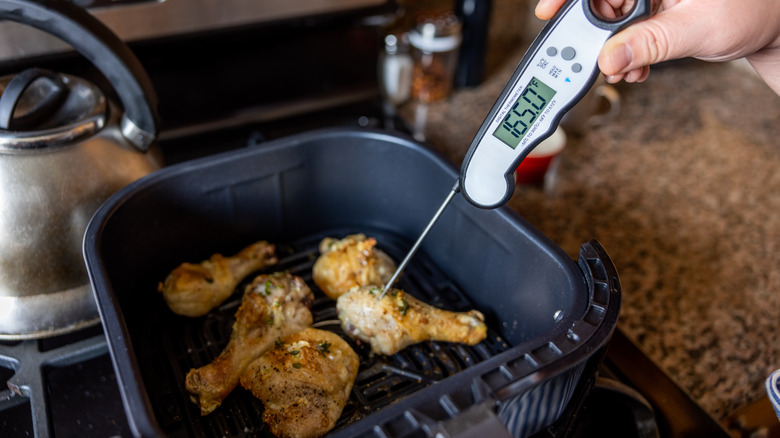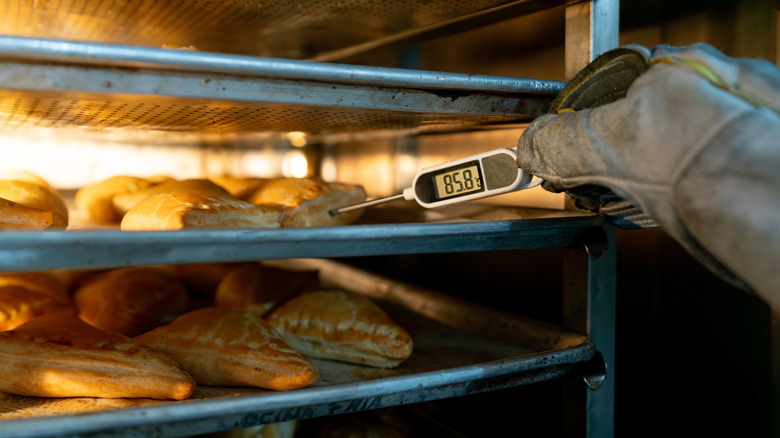3 Mistakes You're Making With Your Meat Thermometer (And How To Avoid Them)
We may receive a commission on purchases made from links.
Out of the many essential kitchen tools that any home cook should have in their cabinets and drawers, a meat thermometer is certainly a must. Small to store and often relatively affordable to buy (unless you get a high-tech option), a meat thermometer is perhaps the easiest way to know if your chicken, steak, or other foods are safe to eat. Like many kitchen tools, there are mistakes that you should avoid for best practice, and we spoke with Roberta Muir, a cookbook author and CEO of Be Inspired, to learn the top three pitfalls to avoid.
Before we get to Muir's expert-level tips, there's a little bit that you should know, especially if you don't have a meat thermometer already. A meat thermometer is different from a candy thermometer because it doesn't typically reach as high of temperatures, but it's easier to insert into meat. And if your kitchen isn't equipped with one already, here are the best meat thermometers according to online reviews, including this ThermoPop 2 that costs $43 on Amazon.
You're not using it correctly
The first mistake you might make with a meat thermometer is not using it properly. "Put it into the center of [the] thickest part of the meat as that's the last place that the heat will reach," says Muir. This might be the center of the roast or the middle of the chicken breast; either way, if you probe the end of a thin part of a steak or chop, it won't register the internal temperature of the thickest part of meat, which is essential to safe eating.
The middle of the meat might not always be the thickest, so be sure to spot the ideal location. It's also important to avoid any bones or large areas of fat to get an accurate reading of the temperature of the meat. Also be sure to give the thermometer a couple of seconds to register the temperature, and even check another nearby spot if you aren't confident about the first reading, because you certainly don't want overcooked or dry meat. For instance, a digital meat thermometer is the key to avoid overcooking pork chops, which tend to be ready rather quickly.
You're only using it for meat
It might often be referred to as a meat thermometer, but the tool has many other uses besides checking on steaks and roasts. "You can use it to probe the core temperature of any food that can be probed," says Muir. Any food that needs to reach a specific internal temperature for safe eating is worth using it on. Just consider what the dish is, because you don't want small probe holes all over certain types of dishes.
In fact, even baking is easier with a meat thermometer to check the temperature of baked goods from cupcakes to loaves of bread to avoid a doughy center. Other dishes that can benefit from a check with a meat thermometer include breakfast casseroles that contain eggs, quiches, and even water that you need to be a certain temperature. And you can also check the temperature of cooking oil if your thermometer reaches a high enough temperature.
You're putting it in the dishwasher
As handy as a dishwasher can be, certain items, like wooden bowls, high-quality knives, and thermometers, should stay away from the appliance. When asked why she cautions against putting a meat thermometer in a dishwasher, Muir said, "Many are digital or have a glass front dial that could be damaged if water got in." For more evidence, the aforementioned ThermoPop 2 meat thermometer has a warning that it's not dishwasher safe but can handle splashes or brief submersion in water.
Luckily, it's not difficult to efficiently clean your meat thermometer. Use hot water and dish soap like you would with any other dishes, then carefully wash your meat thermometer to avoid any of the digital components of the device. Should you be really worried about the cleanliness of the thermometer, especially if it touched raw poultry, clean it with rubbing alcohol or boiling water. Now, test out these tips with your next slow-roasted rib roast or classic roast chicken.



